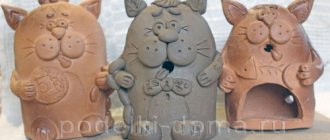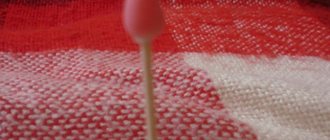DIY polymer clay decorations. Sausages made of polymer clay
Sausages made of polymer clay
- these are blanks for future jewelry, including beads, from which thin
plates-patterns
.
"Sausages"
are also called
"canes"
or
"canes"
(English
cane
).
We offer you a master class on making a very beautiful black and white sausage
, which can be used to create stylish and very original jewelry.
What you will need:
— White and black polymer clay
— Knife or metal plate with blade
- Ruler
— Rolling pin and board for clay
— Rubber gloves to avoid leaving fingerprints
— Extrusion press
Let's get started:
Take two identical pieces of white and black clay and roll them into two squares 8 by 8 centimeters
approximately
0.5 centimeters thick.
Place one layer on top of the other and then divide them into two equal parts. Do this procedure again. You should end up with a striped “sandwich” like this.
Squeeze the resulting rectangle so that you get an elongated round sausage.
Then use your palm to twist the sausage to create a spiral.
. Simply press the sausage onto the table with your palm and roll it in one direction. Do this very carefully so as not to damage the drawing.
If you cut the resulting product in half, there should be a pattern like this
:
Place the sausage inside the clay press
and squeeze out a thin long sausage.
In cross section it will look like this:
Thinly slice the sausage to create a pattern
:
As a result, you can use the drawing for a variety of original decorations:
Watercolor technique
Another method of mixing different colors is more complex, but the result will be unusual.
To work you need to prepare:
- clay (plain and translucent),
- dry pastel,
- knife,
- rolling pin,
- toothpicks.
Operating procedure.
- Carefully grind the dry pastel into powder and mix it with the translucent mass.
- Roll out the resulting workpiece to obtain a flat cake.
- Make two more similar cakes from white clay and any other color.
- Place them on top of each other and roll them out again to a piece about 1 mm thick, cut out a circle.
- Form and roll out a pancake from clay for the base. Place many small pieces of the previous workpiece on it.
- Roll out again with a rolling pin.
It is convenient to cut out flat decoration elements from the resulting blank: petals, circles, hearts.
Polymer clay beads
Multi-colored beads
, which can be used to make a wide variety of jewelry, can be made from multi-colored polymer clay. If you don’t know the specifics of their manufacture, it seems as if the design was applied to these products using paint, but only multi-colored clay was used.
See for yourself.
What you will need:
— Self-hardening polymer clay of 5 colors (in this case white, gray, green, brown and yellow, but any others are possible)
— Knife or metal ruler with blade
— Rolling pin and board for clay
— Rubber gloves to avoid leaving fingerprints
Let's get started:
In order to get a design in the form of a daisy, first you need to “make it up” from clay of different colors. Take white clay and roll it into a sausage about 8 centimeters
and a diameter of
4 centimeters
.
Roll out a plate of gray clay about 2 millimeters
.
Wrap the gray platinum about halfway around the white cylinder, cutting off the excess
knife or ruler.
Take the green clay, roll it into a plate and also wrap the first piece on top of the gray layer
. Trim the resulting sausage, remove excess from the sides.
Using a ruler, make cuts on the white part of the piece as shown in the picture. First in the middle, then two more cuts on the sides so that there is approximately the same distance
.
Then insert the cut out rectangular pieces of the gray plate into the cuts.
Squeeze the resulting sausage, but not too hard, so that all the parts stick together and the air layer between them disappears
.
With your hands you can form the shape of the future petal. The photo shows a petal in the form of a truncated triangle
.
The entire sausage stretched to a length of approximately 30 centimeters
.
The length of the sausage depends on how many petals
you wish to receive.
For example, for this flower the author of the master class is going to make 9 petals, so the length was 32 centimeters
, that is,
3.5 centimeters
per petal. Divide the sausage into 9 parts.
Let's start making the center of the chamomile. Take yellow clay and roll it into a sausage 5 centimeters
and a diameter of
2 centimeters
.
Roll out a plate of brown clay approximately 6 millimeters
and completely wrap it around the yellow sausage.
Then press all the parts so as to maintain the round shape of the sausage.
. After this, start attaching the petals.
You should end up with a daisy
:
Fill the empty spaces between the petals with pieces of green clay:
Completely wrap the daisy with the rolled out green strip
.
Squeeze the daisy sausage
so as to release all the air between the parts.
Then you can start slicing. If you have some of the chamomile sausage left over, store it for future products by wrapping it in film
without air access. Cover the clay ball with daisies cut from the sausage, then smooth it out.
You can make several bead
:
Selection of materials and components for modeling
I'll show you what I have in my polymer clay kit. You can often buy a “starter kit” in stores that should be ideal for working with polymers, but you may already have much of what you need.
You don't need everything listed below here. This is just an overview of what might be useful. The only thing you definitely need is the polymer clay itself.
Clay selection
Today in stores you can find a huge variety of types of polymer clay from different manufacturers. The most common ones are below
- Fimo
- Sculpey
- Premo
- Cernit
- Artifact (from domestic ones)
There really is plenty to choose from. It all depends on the sculpting goals and capabilities. And to simplify this choice, a separate article has been published on the website about the optimal polymer clay for modeling. Read it and all the answers to the questions that arise in your head will be found. At first, it is enough to focus on one of the key manufacturers, depending on what is sold in the nearest store. There is also a separate section on the site dedicated only to the choice of polymer clay. Since this is just the basics of modeling, we won’t repeat it.
When you have decided on the choice of clay, it’s time to move on to choosing your work area and tools.
Selecting a workplace and tool
To work with polymer clay you will need a smooth and clean surface. Whether it's a kitchen table or a separate studio in your own garage doesn't matter. The main thing is that it is comfortable and spacious to accommodate all the “bells and whistles” and direct work.
Now regarding the tools. The site has a separate page about sculpting tools, where you can read about all kinds of tools that may be required in your work.
- There are free
- You can find inexpensive ones
- And there are those that cost a lot of money
But all this is not completely unimportant. The first tool you need at the beginning of your creative journey is HANDS
Everything else comes as you gain experience and understanding.
Oven.
This thing will definitely be needed if you take baked polymer clay (and what happens when it is not baked? Yes. And about this is the link to the article on choosing clay above). However, you don’t even need a special oven, the one in which you cook is enough. Naturally, there will be a few safety tips to follow, but a home oven is fine.
A little advice regarding the workplace
Regarding the starter kit for beginners, we recommend watching a short video
Actually, when we have figured out both the place and the clay, it’s time to move on to the theory of sculpting. You will have to remember or find out some basic things if you didn’t know them before.
Hairpins made of polymer clay
Very simple hairpins can be made using bobby pins and polymer clay
. Here's one option:
What you will need:
- Polymer clay of the desired color
— Invisibility pin
- Glue
Let's get to work
Roll a small ball
, and then crush it into a round disc with your fingers.
Pinch the edges to create a petal
. Make as many petals as you wish.
Connect all the petals together. If you have fire clay, bake the flower to harden the clay. Then you can stick it on the invisible one using a piece of thick fabric.
bobby pins using this simple technique.
:
By the way, hairpins can be made using ready-made flowers and base accessories
. You can use the master classes from the article Flowers made of polymer clay.
Here are some examples:
Making a ladybug
- An insect body is formed from red clay.
- A ladybug head is made from a small piece of black raw material.
- The junction of the parts is leveled, smoothed, and a dividing groove is drawn on the back with a toothpick.
- The petal on which we are going to place the insect is lubricated with liquid plastic.
- We fix the ladybug on the flower, and then send it to the oven for firing.
- Glue a bobby pin to the finished product on the back side of the chamomile.
- Using white acrylic paint, spots are applied to the ladybug's body.
By following these step-by-step instructions on how to make clay jewelry, you can prepare several souvenirs at once and have a supply of gift items.
Polymer clay pendant
This stylish pinecone pendant
easy to do if you have a mold, which you can make yourself from a piece of metal tube.
What you will need:
— Self-hardening polymer clay (black)
- 2 sheets of aluminum foil (golden and silver)
— Drop shape
— Cutting blade for working with clay
— Shiloh
— Accessories for jewelry (pin with loop, chain)
— Pasta machine or rolling pin with a board for rolling out a thin layer
Let's get to work
Roll the foil into a tight ball
.
This will be the central element of our pendant. This core will allow the product not to be too heavy. You can make the center out of clay, but if you wear such a pendant for a long time, an imprint from the chain will remain on your neck.
Using a pasta machine or by hand, roll out a thin layer of clay
and cut out an even circle. Wrap it around a ball of foil. Remove excess clay.
Once the balloon is ready, pierce it with a jewelry pin.
through.
Roll out a sheet of black clay about 3 millimeters
, cover it with a layer of very thin
gold foil
and press it out using a teardrop mold.
Then start attaching the drops one at a time to the round base.
future big shot. Don't worry if the thin layer of gold cracks, it will give a special stylish look to your product.
Cover the entire bud with drops until the very end
.
If you are using baked clay, bake the product at the recommended temperature
. Once it has cooled, attach the chain.
Rules for working with material
In order for the process of making objects from polymer clay to be enjoyable and the result to live up to expectations, you must follow the rules for working with the material:
- The choice of raw materials is approached very carefully; for beginners, cheaper material is suitable, while more experienced craftswomen are recommended to use high-quality clay.
- No need to purchase a whole modeling kit. To begin with, it is better to buy a small block of clay and try it out, combine it with other parts, evaluate its flexibility and bake it.
- Before you start making any decoration, you need to have a gas or electric stove, tools and a board. The packaging with polymer clay will be marked indicating the time and temperature of firing in the oven.
- To maintain the purity of the color of the finished product, work should be carried out with gloves or clean hands.
- To make jewelry you will need special fittings, so before work you need to make sure that there are fastening parts and decorative elements.
Polymer clay beads
We invite you to get acquainted with the unusual technique
of creating jewelry using polymer clay, balls and wire using the following example of creating beads.
You can make entire sets in the same way: beads, earrings, bracelets, pendants.
What you will need:
— Self-hardening translucent polymer clay (several shades)
— Small rubber balls
— Thin wire
- Scissors
— Accessories for jewelry (pin with loop, chain)
— Pasta machine or rolling pin with a board for rolling out a thin layer
— Pin
Let's get to work
1. Inflate rubber balloons to desired size
. You can make balls of different sizes, as shown in this master class, or the same ones. The number of balls will determine the size of the product.
2. Twist a few pieces
wire as shown in the photo to make a loop.
3. Place a loop on the ball where it is tied in a knot
.
4. Cover the ball with wire to form a mesh
.
5. You should have a ball covered with a wire mesh.
6. 7. Remove excess wire ends using scissors
.
8. Roll out a very thin sheet
made of translucent polymer clay.
9. Completely wrap the clay sheet around the wire mesh
.
10. 11. Pop the ball inside with a pin and pull it out through the small hole.
12. Press the clay inward to create a slightly wrinkled sphere.
. Do this very carefully so as not to damage the thin layer of clay.
Let the clay harden thoroughly, and then use special paints to apply the desired design.
.
Step-by-step master class
By following the instructions below, you can make your own, unique plastic pendant. Choose the colors you like from the polymer clay package. Make sure they include light and dark shades - three to five colors is optimal. If you take more than 5 shades, they will blur, and the craft will lose clarity and contrast.
Step 1: Roll out the clay
Using a paste machine or roller, roll out the light green clay as thin as possible.
Cut two identical squares from it.
Repeat the manipulations with polymer clay in white and pink shades. Make sure all squares are approximately the same size.
Step 2: Layer Down
Arrange the squares in this way: first light green, then red and then white, again light green, red and white.
Gently press down the layers.
Cut the structure in half.
Place the halves on top of each other with the white side facing each other.
Step 3: Make the punctures
Press the structure down with your fingers. Align it into a neat square.
Using sharp tools, pierce the layers in a chaotic manner.
Cut the plastic. Insert a thin layer of white clay between the halves and compress the craft again.
Squeeze it into a small cube.
Step 4: Add Holes
Make 3 large holes in the cube.
Insert cylindrical pieces of orange plastic into the holes.
Gently press the cube again.
Step 5: Cut off the layer
Using a sharp knife, cut off the layer of clay horizontally.
Attach a piece of crafts with a design you like to the pendant. Use a knife to trim off the excess.
Insert Mokune Gane into the pendant.
Polymer clay ring
We offer you a master class on making a very simple but original
polymer clay rings in the shape of a bow.
What you will need:
— Polymer clay (desired color)
- Blade
— Pasta machine or rolling pin with a board for rolling out a thin layer
— Sequins
Let's get to work
Knead the clay in your hands to make it more pliable, and roll out a plate about 0.5 centimeters
.
Using a blade or knife, cut out the details for the bow.
: two rectangles (one wider, the other narrower). Fold the edges of the longer one inward, and wrap the other rectangle around the first piece.
You should end up with a bow
:
Make a clay ring
, then attach a bow to it.
In order for the ring to fit you, you first need to wrap it around your own finger
and adjust it to the desired size.
Don't worry if there are fingerprints or imperfections on the ring. With the help of glitter
this problem will be masked.
Cover the ring with glitter
and let it harden.
Photo in accessory
Crafts from polymer clay: step-by-step description of how to make a craft with your own hands
It would be fun to make a pendant with a photograph, because wearing an image of yourself or a photograph of another person framed in an interesting style around your neck has never gone out of fashion. For such a pendant you will need:
- thin transparent plastic;
- two photos;
- transparent glue “Moment”;
- lighter;
- chain;
- scissors.
Cut out identical rectangles from the photos. If you wish, you can cut them in the shape of a heart. We cut out two plastic parts of the same size and shape.
We carefully coat each photograph along its front perimeter with glue and glue it to the plastic part. After this, we glue the photographs to each other with the wrong sides.
Carefully melt the edges of the resulting workpiece around the perimeter with a lighter. The melted edges of the pendant are closed with links of a chain, which gradually sits on the glue along the perimeter. The pendant should dry for at least 20 minutes
The pendant should dry for at least 20 minutes
The melted edges of the pendant are closed with links of a chain, which gradually sits on the glue along the perimeter. The pendant should dry for at least 20 minutes.
This pendant can be attached to the same chain or cord.











